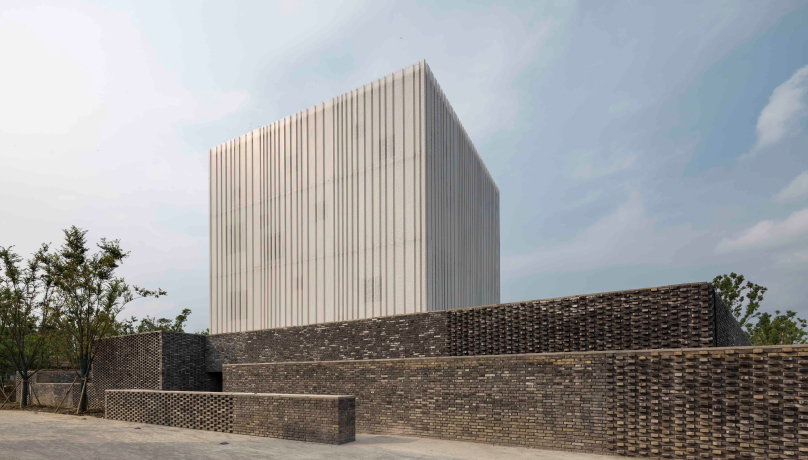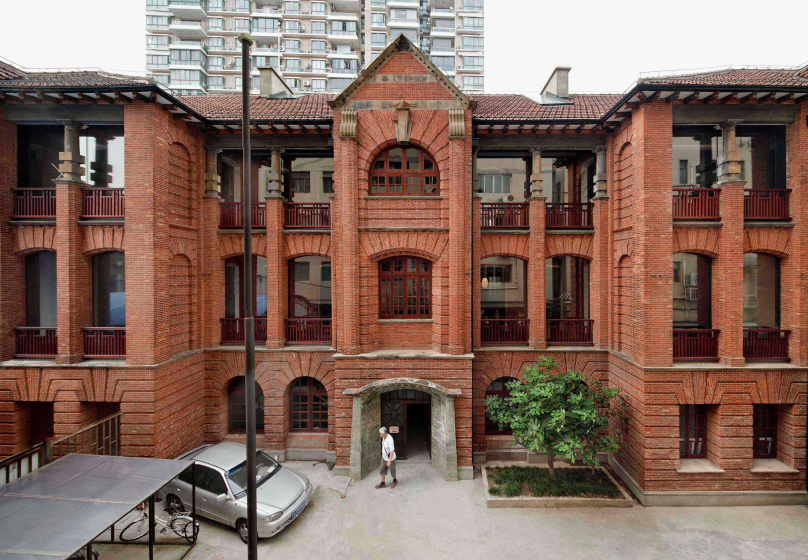Lyndon Neri and Rossana Hu, founders of internationally-acclaimed Neri&Hu are a power couple and an unmistakable force in the global design scene. They founded inter-disciplinary architectural design practice Neri&Hu in 2004, after having worked for a decade long at Michael Graves & Associates in the US. Lyndon grew up in the Philippines and received his Masters of Architecture at Harvard University, while Hu grew up in Taiwan and received her Masters of Architecture at Princeton, but crossed paths when they were pursuing their undergraduate degrees at the University of California, Berkeley.
Based in Shanghai, they have amassed success with many notable awards. Neri&Hu is the winner of Madrid Design Awards 2020, the Overall Winner of The Blueprint Award for Design 2019 and The PLAN Award 2018. They are named EDIDA Designers of the Year 2017 and Interior Designers of the Year of Iconic Awards 2017 by the German Design Council, Maison&Objet Asia Designers of The Year 2015, and Wallpaper* Designers of The Year 2014. In 2013, Lyndon was inducted into the U.S. Interior Design Hall of Fame. The practice was selected as the 2011 INSIDE Festival Overall Winner, won AR Awards for Emerging Architecture 2010 by Architectural Review (UK), and was one of the Design Vanguards in 2009 by Architectural Record (US).
Together, Lyndon and Rossana also founded Design Republic, a retail concept store that congregates product collections from designers around the world. Asia Designers Directory speaks with this pair of distinguished design personalities to understand their influences and design philosophies. Read the interview in full below.
Neri&Hu has been awarded many design accolades since its inception in 2004. How do you complement each other at work? What do you attribute your success to?
We work together as a team. Of course, other strengths come into play when we work on a project together. Generally most things are shared, and we work very organically depending on time, availability, and interest. We have different strengths, and make up for each other’s weaknesses. Lyndon is better at the concept stage, and is very good working with drawing. Rossana is better at the development stage, and works better with words and thoughts rather than drawings. Both aesthetic senses are quite similar, and both usually share the same big picture for the projects.
A lot of architectural practices are shared by husband and wife teams, maybe the demands of work make it only possible that we work together to stay married. Anyhow, it’s also fun and interesting to share life and work together, so that even when we travel we are looking at things that relate to our work…it’s a constant dialogue about design and work/life is quite inseparable
 Junshan Cultural Center
Junshan Cultural Center
Can you describe your design philosophy?
 Rethinking the Spilt House
Rethinking the Spilt House
Whether through objects of intimate daily use or vessels of inhabitation, we seek an approach to design that draws from multiple disciplines to provide experiences that enrich contemporary life while still keeping a critical linkage to a collective history.
A quote by Saint-Exupery expresses both our design and life philosophy well: We don’t ask to be eternal beings, but we ask that things do not lose all their meaning.
Which project resonates with you most and why?
Hard to pinpoint one project to define our practice. All the projects we have been involved with the last 15 years have resonated with us in different capacities.
You were born and raised in the Philippines/Taiwan, studied and worked in the US for many years before eventually relocating to China. How has this experience shaped your perspective on design?
We are both born in different parts of the world than that of our grandparents, grew up learning multiple dialects, then went to school in the west, learned English, then moved back to Asia to practice our profession. Our background is like a mixture of many different things collapsed together. Our office is similar, it is made up of many nations and tongues, ideas and tastes.
Studying abroad pretty much formed the foundation of our architectural thinking and design process. Design elements are not like chemicals you can mix into a formula and create results. It is a much more artistic and undefinable process, but everything we come into contact with becomes who we are and that builds the inspiration pool for our work.
When we were younger it was extremely important to address the identity issue of design in everything we worked on. Our design process was not affected too much by our cultural identity, but rather we see it as a natural outcome of who we are, where we come from, and our background inevitably will surface in everything we do.
 Suzhou Chapel
Suzhou Chapel
What prompted your decision to base your practice in Shanghai? How has the design landscape in China transformed over the years?
In 2004, we started our own studio. The move to China was propelled by a project in Shanghai. The client requested to have Lyndon’s physical presence there for a short stay – the short stay led to a long stay, and we realised how much we would be able to contribute and be a part of an exciting era for Chinese architecture, so we made the move. And Rossana’s father was from Shanghai, and she felt it was a personal coming-back-forth circle for her to move back and to practice in Shanghai.
Shanghai’s design scene is being infiltrated with global energy and design influence on a daily basis, and the absorption rate is extremely high. The problem that comes with this phenomenon is that people are not quite critical about what they see and use, so regardless of good/bad, appropriate/inappropriate, they are all being taken in.
The traditional western architectural tradition forms the basis of our education, but culturally we are very much Chinese, and there are influences particularly in our work that’s located in China. We also like to examine local culture of where our work is so that depends on where the project is located.
How do you think you have grown both personally and professionally over the years?
Some things remain and some have changed. The important ones stay the same and hopefully will never change. As designers, we respond to trends and the changing patterns of use, so we believe that we not only respond to them as they come, we need to anticipate them ahead of their arrival. We have been predicting trends, but we do think ahead and assume new problems for a new age that is to come. Those things that don’t change are things that are intrinsically ours, for example, our worldview, aesthetic concern, personality, to name a few.
In many ways, as a designer, we feel that the more we work the less we know. We just have this thirst to want to gain more knowledge yet feel the urgency that a person’s lifetime is so short to get a full understanding of things they need to know.
The biggest reward is seeing our work come to reality and things being built. Through it we understand how we need to be better each time.
 Design Republic Design Commune
Design Republic Design Commune
You also have an office in London. How is the architectural or design landscape between China and the UK different?
Shanghai is mostly different from London because it is an Asian city, so the qualities of Asia/China is embedded within everything we see around the city. It is also very raw in certain parts, in ways that you can no longer see in more modernised cities like London. For example, within some lanes and in small strips of the city you cannot see any sign of the world at large – it’s still like how the city was 20 years ago, and that in itself is very charming.
The on-going pandemic has resulted in global lockdowns with many working from home indefinitely. Events, exhibitions and learning have also moved online. Has this given you a newfound perspective on the design of private and public spaces? Will future homes or public spaces be different in a post-COVID world and how?
We believe public spaces as we understand will change and be more private, and private spaces will become more public.
 No.31 at Jing’an, Shangai
No.31 at Jing’an, Shangai
Can you tell us more about the design concept behind your new studio, No. 31?
Since the founding of the practice in 2004, we have occupied various old buildings in different areas of Shanghai. We started in the Former French Concession by taking over a concrete box hidden in a Shanghainese alleyway. When the practice grew, we relocated and renovated a 5-storey building and took over 3 storeys of it and called it the black box. This time, in Jing’an, we created a new black box out of a former staff dormitory. For us, there is always some value to be found in these urban artifacts that are closely interwoven with the fabric of the city, even if they seem unremarkable, they bring a sense of continuity that something created from a tabula rasa could not offer. This ethos of adaptive reuse has become an integral part of our practice.
No. 31 is a culmination of many “obsessions” we’ve been exploring in our practice since day one. The renovation strategies employed are based on the notion of “reflective nostalgia,” as a way to honor history and heritage without having to recreate it literally. We talk about the practice being “inter-disciplinary” and it’s demonstrated clearly here through the seamless integration of architecture, interiors, furniture and graphics. We are also champions for the design community at large in Shanghai, which is why we started Design Commune 10 years ago, and why we have opened up so many of the spaces in No.31 to share with our community. On the ground floor, there is an art gallery, two furniture stores and a cafe. Part of the second floor is used for a co-working space and also the office of Design Republic. Neri&Hu occupies the third and fourth floor. At the same time, the project is not only a consummation of everything we’ve done thus far, it’s also the start of many new beginnings for us, as we continue to grow as a practice.
